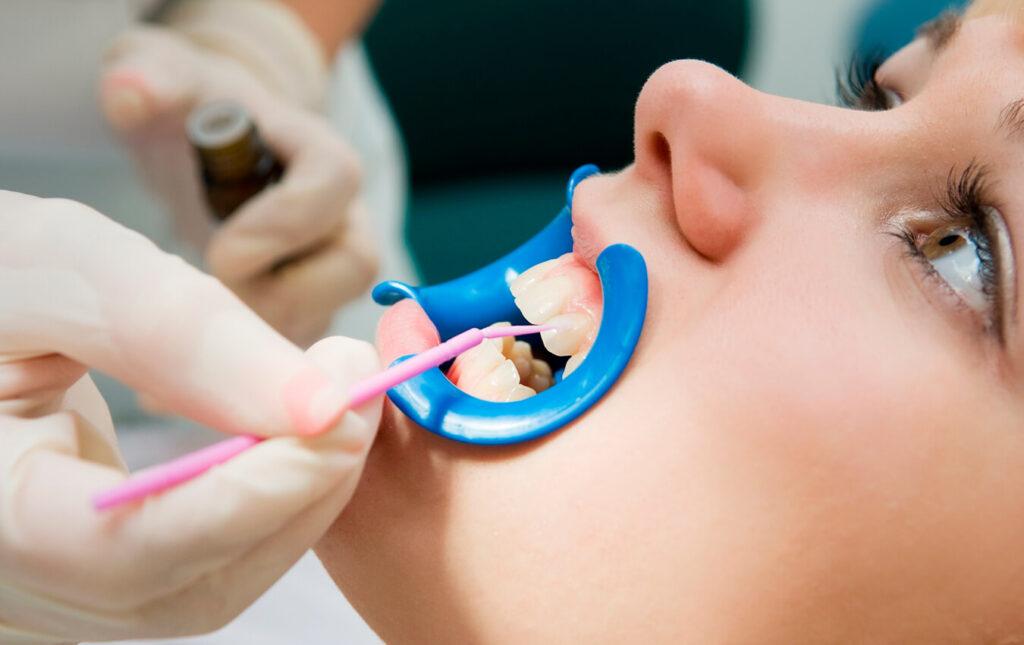
Minerals like fluoride, calcium, phosphate are found inside the enamel – the visible layer of the crown of the tooth. They are constantly affected by the process of demineralization which is caused by acids resulted from the combination of bacteria and sugar in one’s month. Another process – remineralization – helps regaining the minerals and redepositing fluoride, calcium and phosphate inside the enamel. When the two processes are not balanced, demineralization being stronger, the result is tooth decay. Fluoride treatments contribute to speeding the remineralization process and destroying the production of acids by bacteria. There are two ways of embodying fluoride into teeth: through food, supplements and fluoridated water which incorporate the fluoride into teeth by means of blood; through direct appliance performed at the dentist’s, when brushing with fluoride toothpaste or when using fluoride rinse and fluoridated water.
Fluoride treatments are applied successfully especially on children whose teeth are developing. They are usually repeated every six months. For children over 6, fluoride treatment such as mouth rinses and gels is generally used. Additional treatment can be provided by fluoride supplements which are available as liquids or tablets prescribed by pediatricians or dentists.
As for adults, anyone who feels at risk as far as remineralization is concerned should follow fluoride treatment. Demineralization on adults appears with those who have a history of cavities and poor rushing habits or those who hardly visit the dentist. Other adults who are candidates for fluoride treatments are those who are under medication such as antihistamines or medications for high blood pressure, anxiety or depression. These cause a dry mouth and without saliva, tooth decay is encouraged.
Benefits
- Stronger and cleaner teeth
- Improved breath quality
Who is this procedure for?
- People with week teeth.
- Those who have a history of cavities and hardly visit the dentist.
- People with poor rushing habits
What happens before the procedure?
Before beneficiating from an in-office fluoride treatment, teeth are dried and cleaned. This means that stains are polished away from the teeth surface. In the case of home usage of fluoride rinses or gels, brushing and flossing the teeth are necessary processes. The most suitable time for using fluoride products is at night just before bedtime. This provides less possibility for these products to be washed or rinsed away.
What happens during the procedure?
Fluoride treatments applied in dental offices are more advisable since they contain a higher concentration of fluoride than mouthwash water or toothpastes. They are suitable for both children and adults. This type of fluoride treatment has the advantage to stay on the teeth longer, having a stronger chemical concentration or minerals. Two types of professional fluorides are commonly applied: acidulated phosphate fluoride (APF), which is acidic, and neutral sodium fluoride, which is not. The later is more suitable for people who have dry mouth (xerostomia) or who have tooth-colored fillings or crowns. Fluoride can be applied in the form of gel, foam or varnish. Fluoride can be applied by using a tray that looks like a mouth guard for one to four minutes or it can be painted directly on the teeth.
As for fluoride supplements, they are commonly recommended to children. They take these supplements every day in small quantities, ranging from 0.25 to 1 milligram per day. The amount of fluoride supplement varies according to the children’s age and to the amount of fluoride in the water they drink.
What happens after the procedure?
After the different procedures are performed, experts advise not to eat, drink or smoke for at least 30 minutes. This helps to increase the fluoride’s contact with the teeth

